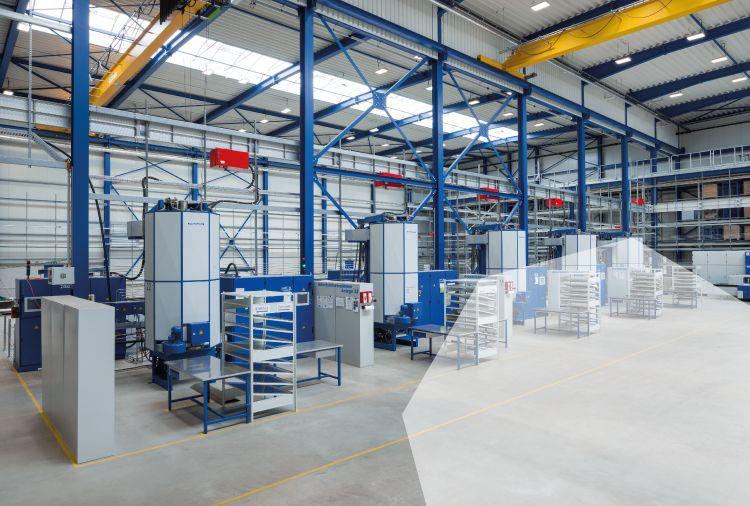
What is plasma nitriding? How does a nitride layer arise?
What is plasma nitriding? How does a nitride layer arise?
Plasma nitriding is a thermochemical diffusion process for surface layer hardening. In this process, a surface layer of a workpiece or component is enriched with nitrogen. As a result, a wear and corrosion protection layer forms on the component surface and in the area near the surface.
Plasma nitriding occurs at very low temperatures. It is therefore an extremely low-warpage process for surface hardening.
Expert knowledge on the subject
The nitride layer
The nitride layer consists of different areas depending on the nitrogen potential and the temperature. Starting out from the base material, we first reach the diffusion zone, within which the nitrogen content increases as you get closer to the surface. The zone connects to the compound layer, which in turn can consist of two phases: the γ’ nitride with the composition Fe4N with a hexagonal structure; and the nitrogen-rich ε nitride with the composition Fe2-3N with a face-centred cubic lattice structure.

Fig. 1: metallographic cut of a plasma nitrided compound layer on 16MnCr5

Fig. 2: compound layer structure (schematic)
As is clear from the two-element system Fe-N, the maximum nitrogen solubility in α - iron at 592°C is approx. 0.115 wt%. When the nitrogen content increases, the γ’ nitride layer forms, the nitrogen content of which is 5.7 to 6.1 wt%. With a nitrogen content of 7.7 to 11.1 wt% the ε nitride layer forms [1]. In addition, there is also a ζ phase that exists with a nitrogen content of approx. 11.4 wt%, but which is of no technical significance.

Fig. 3: Iron–nitrogen phase diagram [2]
The development and structure of nitride layers
To produce a nitride layer, nitrogen must be taken from the surroundings into the material to be nitrided. The diffusion of nitrogen into the material requires the presence of a high temperature. Ferrous materials are nitrided at temperatures of 400 to 630°C [3]; titanium materials at 600 to 800°C [4]. The lower value arises for economic reasons because the treatment times at temperatures that are too low are no longer efficient due to slowed diffusion. The upper value arises in the case of iron due to the thermodynamics of the formation of the braunite phase, which is usually not desired because of its mechanical properties, as well as with titanium, especially due to the dimensional stability and form retention. What all nitriding processes have in common is that the nitrogen, once it has reached the surface, becomes integrated interstitially in the crystal lattice and diffuses further into the workpiece through interstitial sites. The FE-N equilibrium phase diagram (Fig. 2) describes in detail the phases arising here based on the temperature and nitrogen potential. In unalloyed steels, when the nitriding temperature is slowly cooled to room temperature, coarse γ´ and submicroscopic α´´ nitrides (Fe16N2 and Fe8N) are precipitated. Through the absorption of nitrogen in the present cementite precipitate, carbon nitride or nitrocarburide of the form Fe2 (N,C)1-x arise [5].
In alloyed steels, the diffusing nitrogen and present nitride formers form submicroscopic precipitate face-centred cubic nitrides. Nitrogen also accumulates in the structure of present cementite or carbides of other alloying elements, which results in carbon nitride formation [3].
If the nitrogen concentration reaches of a value of 6 wt%, then there is the nucleation of γ´ precipitate at existing nucleation sites. Starting from the nucleation sites, these spread out over the entire surface. ε nitrides also form on the γ´ nitrides upon reaching a nitrogen concentration of 7.7 wt%, with these also spreading out over the entire surface.

Fig. 4: schematic curve of layer growth during the nitriding/nitrocarburising of pure iron
Next during the nitriding process, the thickness of the nitride layer increases, whereby the rate of growth drops as the duration increases due to the ever increasing impediment to diffusion [5, 6, 7].
Carbon can also be integrated into the compound layer. This is supplied to the material from the reaction medium and the base material. Nitride layers are obtained as per the three-element system Fe-C-N (Fig. 5)

Fig. 5: three-element phase diagram Fe-C-N, section at 575°C [8]
Of interest here is the possibility of forming dense ε nitride layers with low nitrogen contents because the carbon stabilises the ε phase. While carbon is always supplied in salt bath nitrocarburising, this can be controlled in gas nitriding and in plasma nitriding through the composition of the gas. CO2 or CH4 are used as carbon donors.
[1] DIN EN 10 052, Vocabulary of heat treatment terms for ferrous products, version 1994-01. [2] Wriedt, H.A., Gokcen, N.A., Nafziger R.H.: The Fe-N-System, Bulletin of Alloy Phase Diagrams, 1987, Vol. 8, No. 4, p. 355/77. [3] Liedtke, D.: Wärmebehandlung von Eisenwerkstoffen Nitrieren und Nitrocarburieren, 3rd edition, Expert Verlag, Renningen. [4] Preißner, F.; Minarski, P.; Mayr, P.; Hoffmann, F.: Hochdrucknitrieren von Titanwerkstoffen, Härterei-Techn. Mitt. 46 (1991) 6, p. 361/66. [5] Hoffmann, R.; Mittemeijer, E.I.; Somers, M.A.J.: Verbindungsschichtbildung beim Nitrieren und Nitrocarburieren, Härterei-Techn. Mitt. 51 (1996) 3, p. 162/69.0 [6] Somers M.A.J.; Mittemeijer E.J: Verbindungsschichtbildung während des Gasnitrierens und des Gas- und Salzbadnitrocarburierens, Härterei-Techn. Mitt. 47 (1992) 1, p. 5/13. [7] Hong, D.: Gaseous Nitriding and Nitrocarburising, Thermodynamics and Kinetics, Stockholm, 1994, (dissertation). [8] Slycke, J.: Thedrmodynamics of Carbonitriding and Nitrocarburising and the Fe-N-C Phase Diagram, Tagungsband AWT-VWT-Tagung Nitrieren und Nitrocarburieren 24–26/ 4/1996, Weimar, p. 19/28.